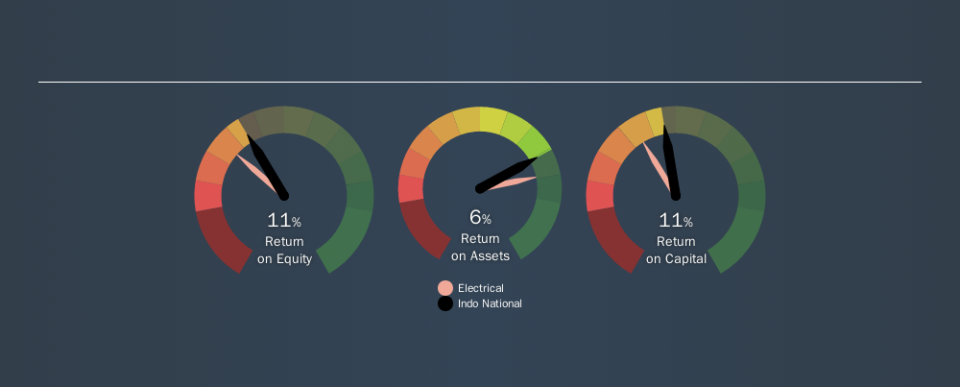Should You Care About Indo National Limited’s (NSE:NIPPOBATRY) Investment Potential?

Today we'll evaluate Indo National Limited (NSE:NIPPOBATRY) to determine whether it could have potential as an investment idea. Specifically, we're going to calculate its Return On Capital Employed (ROCE), in the hopes of getting some insight into the business.
Firstly, we'll go over how we calculate ROCE. Second, we'll look at its ROCE compared to similar companies. And finally, we'll look at how its current liabilities are impacting its ROCE.
What is Return On Capital Employed (ROCE)?
ROCE is a measure of a company's yearly pre-tax profit (its return), relative to the capital employed in the business. Generally speaking a higher ROCE is better. Overall, it is a valuable metric that has its flaws. Author Edwin Whiting says to be careful when comparing the ROCE of different businesses, since 'No two businesses are exactly alike.'
So, How Do We Calculate ROCE?
Analysts use this formula to calculate return on capital employed:
Return on Capital Employed = Earnings Before Interest and Tax (EBIT) ÷ (Total Assets - Current Liabilities)
Or for Indo National:
0.11 = ₹328m ÷ (₹4.8b - ₹1.8b) (Based on the trailing twelve months to June 2019.)
Therefore, Indo National has an ROCE of 11%.
View our latest analysis for Indo National
Is Indo National's ROCE Good?
ROCE is commonly used for comparing the performance of similar businesses. Using our data, Indo National's ROCE appears to be around the 13% average of the Electrical industry. Setting aside the industry comparison for now, Indo National's ROCE is mediocre in absolute terms, considering the risk of investing in stocks versus the safety of a bank account. It is possible that there are more rewarding investments out there.
Our data shows that Indo National currently has an ROCE of 11%, compared to its ROCE of 8.2% 3 years ago. This makes us think the business might be improving. You can click on the image below to see (in greater detail) how Indo National's past growth compares to other companies.
When considering ROCE, bear in mind that it reflects the past and does not necessarily predict the future. ROCE can be misleading for companies in cyclical industries, with returns looking impressive during the boom times, but very weak during the busts. ROCE is, after all, simply a snap shot of a single year. You can check if Indo National has cyclical profits by looking at this free graph of past earnings, revenue and cash flow.
Do Indo National's Current Liabilities Skew Its ROCE?
Liabilities, such as supplier bills and bank overdrafts, are referred to as current liabilities if they need to be paid within 12 months. The ROCE equation subtracts current liabilities from capital employed, so a company with a lot of current liabilities appears to have less capital employed, and a higher ROCE than otherwise. To counter this, investors can check if a company has high current liabilities relative to total assets.
Indo National has total liabilities of ₹1.8b and total assets of ₹4.8b. As a result, its current liabilities are equal to approximately 37% of its total assets. Indo National has a medium level of current liabilities, which would boost its ROCE somewhat.
What We Can Learn From Indo National's ROCE
With this level of liabilities and a mediocre ROCE, there are potentially better investments out there. Of course, you might also be able to find a better stock than Indo National. So you may wish to see this free collection of other companies that have grown earnings strongly.
For those who like to find winning investments this free list of growing companies with recent insider purchasing, could be just the ticket.
We aim to bring you long-term focused research analysis driven by fundamental data. Note that our analysis may not factor in the latest price-sensitive company announcements or qualitative material.
If you spot an error that warrants correction, please contact the editor at editorial-team@simplywallst.com. This article by Simply Wall St is general in nature. It does not constitute a recommendation to buy or sell any stock, and does not take account of your objectives, or your financial situation. Simply Wall St has no position in the stocks mentioned. Thank you for reading.

